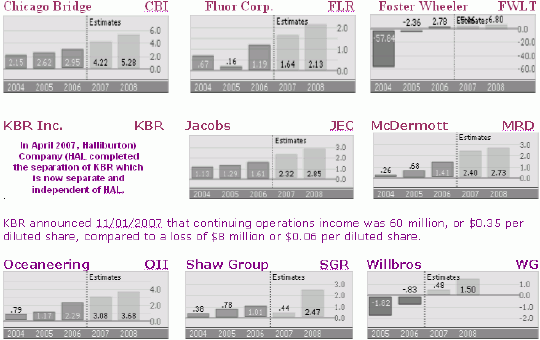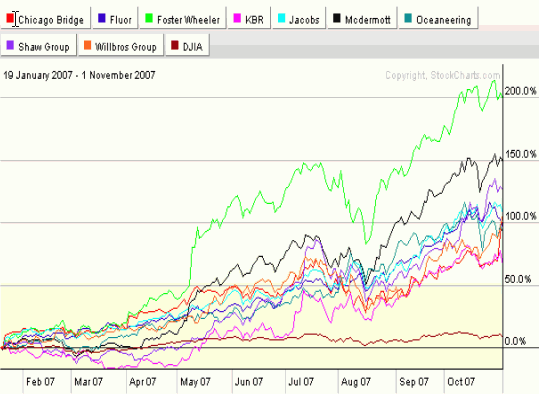Today I’m pleased to bring you a report on the oil/gas engineering industry written from the perspective of someone who has more than 40 years of experience working for major oil corporations as well as smaller companies all across the globe. Robert Williams has extensive petroleum, water and electrical industries experience regarding Supervisory Control and Data Acquisition (SCADA) systems, Management Information Systems (MIS/IT), Distributed Control Systems fire & gas/emergency shutdown systems, instrumentation, metering, communications, security/CCTV and electrical engineering on such major projects as Shell Bonga FPSO, Saudi Strategic Storage Project, Libyan Water Pipeline, Trans Alaska crude oil pipeline, Alaska Natural Gas Transportation System, Occidental Piper B and Saltire offshore platforms and many other worldwide projects.
Oil & Gas Industry Perspective Part I
by Robert Williams, PhD, P.E.
 This is the inauguration issue of the Oil & Gas Industry Perspective published with the express purpose of keeping you abreast of industry trends and developments and to potentially identify investment opportunities. Industry sectors involved are the Integrated Companies, Services and Equipment Companies and Operations Companies. All these industry sector companies are involved with future developments capital expenditures either for exploration, production, distribution or for technological advancements. Not included in these Oil/Gas industry sectors is one industry which is highly involved with oil and gas developments. This industry is the engineering companies that are listed under engineering because many are also diversified into environmental, power, federal government, pharmaceuticals, nuclear and life sciences engineering projects.
This is the inauguration issue of the Oil & Gas Industry Perspective published with the express purpose of keeping you abreast of industry trends and developments and to potentially identify investment opportunities. Industry sectors involved are the Integrated Companies, Services and Equipment Companies and Operations Companies. All these industry sector companies are involved with future developments capital expenditures either for exploration, production, distribution or for technological advancements. Not included in these Oil/Gas industry sectors is one industry which is highly involved with oil and gas developments. This industry is the engineering companies that are listed under engineering because many are also diversified into environmental, power, federal government, pharmaceuticals, nuclear and life sciences engineering projects.
Industry Perspectives
1. All across the world major oil companies, Exxon, Royal Dutch Shell, Chevron/Phillips, Marathon, etc. and Middle East national oil corporations, e.g. Kuwait are all in various degrees of revamping their existing refineries with the express purpose of increasing overall refining capacity, and where necessary, adding heavy crude oil refining capability.
2. Major capital expenditure projects are financed by the continuously increasing crude oil prices. Current crude oil prices are sufficient to provide a return on investment and in most cases the necessary capital is already justified and committed to the refinery expansions. Refinery revamp projects are currently ongoing in California, Texas, Louisiana, Michigan and other states. Front End Design (FEED) and Engineering Procurement Construction (EPC) contracts have been placed with engineering contractors who have specialized skills to complete these projects.
3. Specialized skills include positive experience on similar projects, project management capability, project control systems with competitive rates and qualified engineering, procurement and construction personnel.
4. In 1982 there were 301 refineries in the USA but in 1992 there were only 199; 2002 only 153 and in 2007 the number of refineries was down to 149. Crude oil pricing went the opposite direction from $18.91 in 1990, to $23.17 (Jan, 2000); $28.00 (Jan, 2004); $35.16 (Jan, 2005); $55.12 (Jan, 2006); $54.63 (Jan, 2007); $94.44 (Nov, 2007), and January 2008 100 ++?? (Source: US Energy Information Administration) [Hyperlink to www.eia.doe.gov]
5. Gasoline refining in the US has not kept up with demand with the shortfall being made up by imports with an estimated current import of 1 million barrels. A good size refinery is about 250,000 barrels per day of crude oil.
6. No new refineries have been built in the US for the past 25 years.
7. Refined products consumption will continue to increase as will the political pressure for gasoline imports independence.
8. During the 80’s and 90’s the oil/gas industry suffered a major downturn and no major projects were initiated to replace older equipment and technology. A result is the ongoing maintenance shutdowns for US refineries.
9. Similarly, the major oil/gas companies and the EPC engineering contractors divested themselves of professionally qualified and experienced engineers of all disciplines. Newly assigned engineering projects are being partially staffed from returnee engineers, retired engineers and new graduate hires. A major experience gap exists in staffing these projects.
10. During the industry downturn there was a trend toward lump sum contracting for global capital projects. This trend has now reversed back to the cost plus reimbursable projects.
11. An EPC contractor does not make any major capital expenditures for the refinery revamp engineering projects since they only provide the necessary business requisites to supply experienced project managers and engineering personnel and supporting infrastructures, of buildings, computers, networks, etc.
12. One EPC contractor outlines the backlog of engineering contracts of up to five years without any new contracts being granted.
13. Domestic refining capacity is expected to grow based on the current capital expenditure projects to revamp existing refineries but this will be offset by increasing consumption. Is this another refining industry overbuild? It may very well be but this will not become apparent for quite a few years until these refinery revamp project deliver the increased production capacity which could be utilized to reduce crude oil and petroleum products imports rather than flood the US market.
14. In previous years capital investment was directed to lower carbon emissions and to meet low-sulfur regulations. These environmental investments do not expand capacity as the currently ongoing revamp projects will as they are also designed to increase heavy crude oil refining, i.e. Canadian tar sands.

The oil/gas engineering companies combined performance charts (see chart) positively indicates that profits are being made and that it is not too late to invest in these companies. All are indicating increasing earnings and the Insider Perspective is that from three to five years of backlog are recorded by these companies. Backlog means that they would be busy for three to five years to complete existing client-approved capital expenditure projects without consideration for any new projects being negotiated or bids under preparation. Please note that recent markets declines do affect these companies’ stock pricing but may very well provide excellent entry points depending on your market timing criteria. Weekly charts provide trend direction determination whereas daily or even 60-mintue charts provide guidance as to trade entry points.

In summary, the oil/gas engineering industry is currently investing on crude-oil dependence growth which is a fundamental sign for improved earnings and rising stock prices.
Disclaimer: No position is owned in any of the companies written about above.
kindly send me a list of top 20 international oil and gas engineering companies.
It is really an impressive insight to the world of oiland gas
need more information regarding the AMEC OIL AND GAS COMPANY.. I RECVED A JOB OFFER LETTER. WANT TO KNOW ITS CORRECT OR FRAUD..